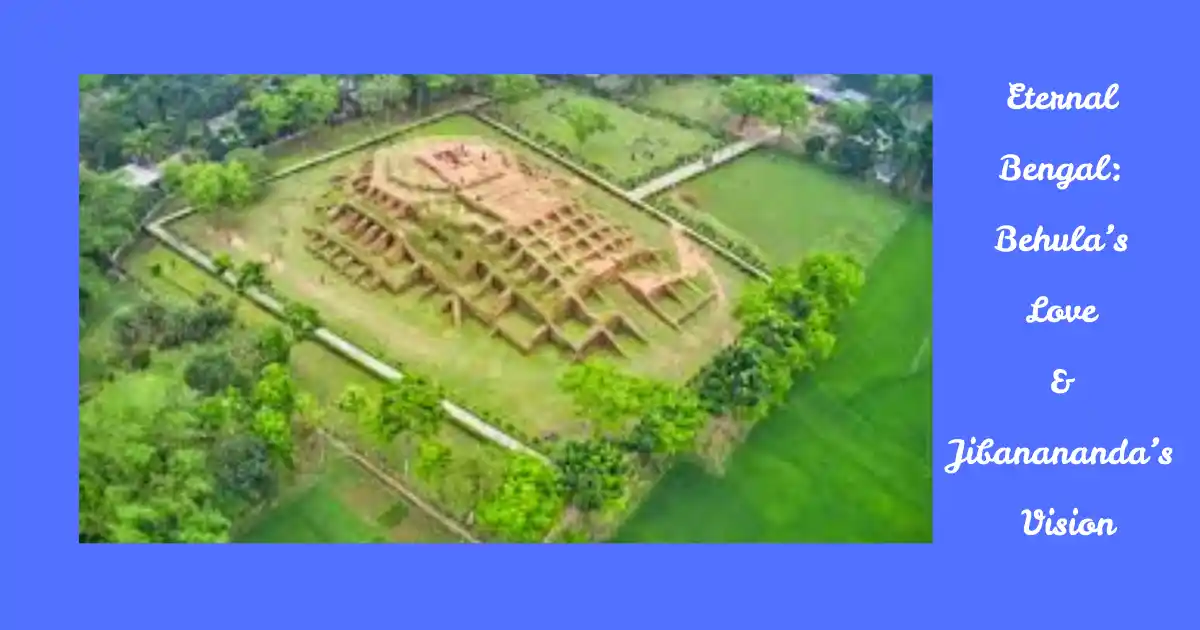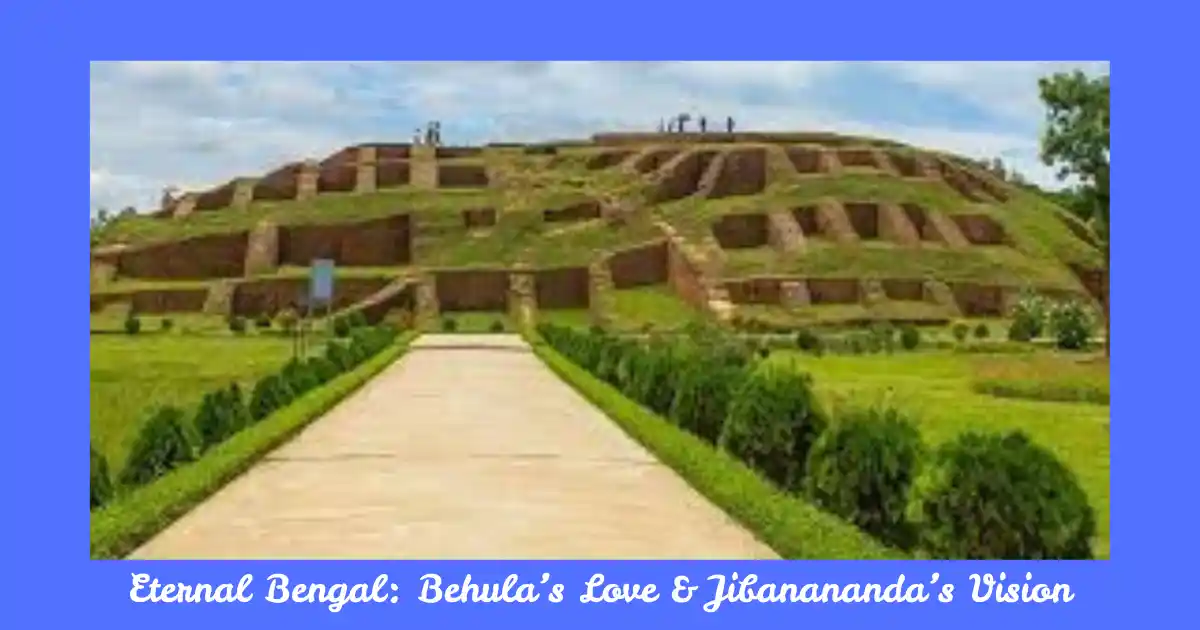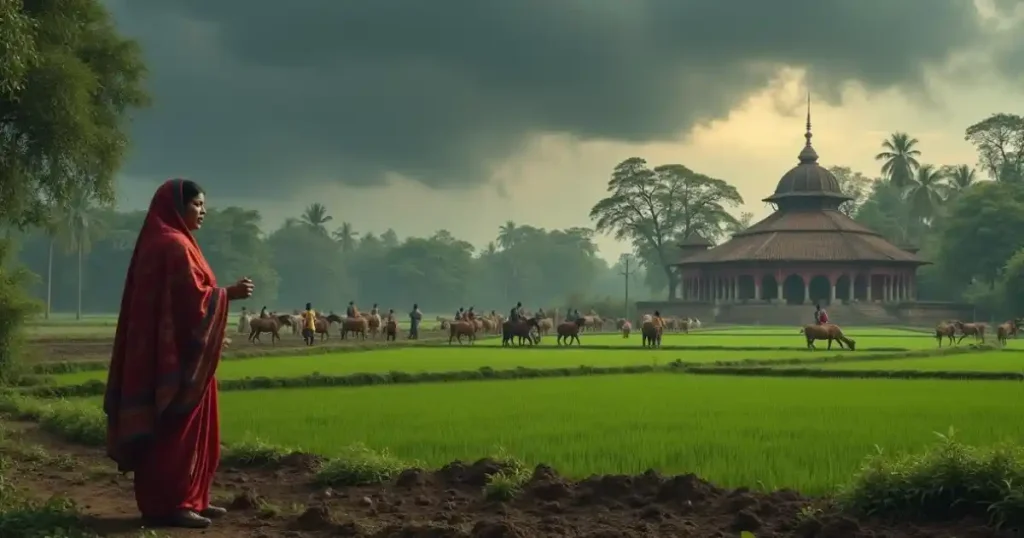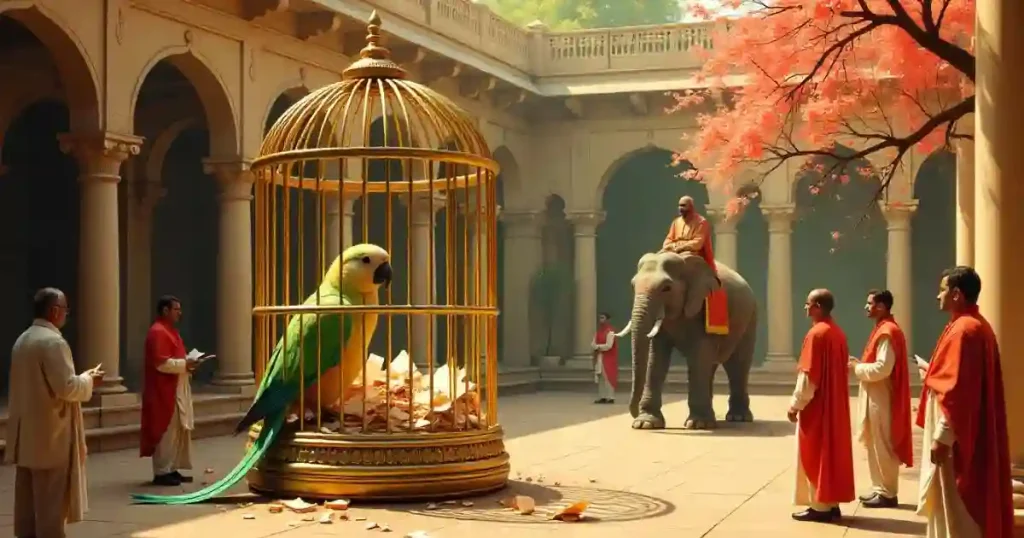Eternal Bengal lives not only in its lush rivers and whispering trees but also in its timeless tales of love and resilience. Jibanananda Das, in his iconic poem I Have Seen Bengal’s Face, captures the serene splendor of Bengal’s landscape—the fig trees, the swallows at dawn, and the silence of ancient trees.

Alongside this poetic vision, the legend of Behula from Manasamangal echoes Bengal’s deep-rooted mythological past, where a devoted wife braved death and gods for love. Together, these two narratives paint a powerful portrait of Bengal—rich in beauty, culture, and emotion. This article delves into the poetic imagery and folk heroism that define the spirit of Eternal Bengal.
Read more – 9 Inspiring Facts About S M Sultan, Genius of Bangladeshi Art
I Have Seen Bengal's Face
Because I have seen Bengal's face I will seek no more,
The world has not anything more beautiful to show me.
Waking up in darkness, gazing at the fig-tree, I behold
Dawn's swallows roosting under huge umbrella-like leaves.
I look around me and discover a leafy dome,
Jaam, Kanthal, Bat, Hijol and Aswatha trees all in a hush,
Shadowing clumps of cactus and zedoary bushes.
When long, long ago, Chand came in his honeycombed boat
To a blue Hijal, Bat Tamal shade near the Champa, he too sighted
Bengal's incomparable beauty. One day, alas, in the Ganguri,
On a raft, as the waning moon sank on the river's sandbanks,
Behula too saw countless aswaths bats besides golden ricefields
And heard the thrush's soft song. One day, arriving in Amara,
Where gods held court, when she danced like a desolate wagtail.
Bengal's rivers, fields, flowers, wailed like strings of bells on her feet.
Important Words and Phrases of the poem (Eternal Bengal)
| Word/Phrase | Bangla Meaning |
| Bengal’s face | বাংলার মুখ / বাংলার সৌন্দর্য |
| seek no more | আর কিছু খুঁজবো না |
| fig-tree | ডুমুর গাছ |
| Dawn’s swallows | ভোরের আবছা আকাশে ওড়াউড়ি করা পাখি |
| umbrella-like leaves | ছাতার মতো বড় পাতা |
| leafy dome | পাতায় ঘেরা গম্বুজ |
| Jaam, Kanthal, Bat, Hijol | জাম, কাঁঠাল, বট, হিজল গাছ |
| Chand | চাঁদ সদাগর (লোককাহিনির চরিত্র) |
| honeycombed boat | মধুর মতো গঠিত নৌকা |
| Behula | বাংলা পুরাণের নায়িকা, চাঁদের স্ত্রী |
| Amara | স্বর্গ বা দেবতাদের বাসস্থান |
| desolate wagtail | একাকী খঞ্জন পাখির মতো |
| wailed like strings of bells | ঘণ্টার সুরের মতো বিলাপ |
Line-wise Bangla Explanation
Lines 1-2:
“Because I have seen Bengal’s face / I will seek no more”
→ কবি বলেন, তিনি বাংলার মুখ দেখেছেন, তাই পৃথিবীর আর কোনো সৌন্দর্যের সন্ধানে তার ইচ্ছা নেই। বাংলার প্রকৃতি তাঁর কাছে সর্বশ্রেষ্ঠ।
Lines 3-4:
“Waking up in darkness… umbrella-like leaves.”
→ ভোরের অন্ধকারে তিনি ডুমুর গাছের দিকে তাকিয়ে দেখেন, বিশাল পাতা ছাওয়া গাছের নিচে পাখিরা বিশ্রাম নিচ্ছে।
Lines 5-7:
“I look around me…zedoary bushes.”
→ চারপাশে তাকিয়ে তিনি দেখতে পান পাতার তৈরি এক গম্বুজ, যেখানে বিভিন্ন গাছ যেমন জাম, কাঁঠাল, হিজল ও অশ্বত্থ নিঃশব্দে দাঁড়িয়ে আছে। ছায়ায় রয়েছে ক্যাকটাস ও নানা ওষধি গাছ।
Lines 8-10:
“When long, long ago, Chand…Bengal’s incomparable beauty.”
→ বহু আগে চাঁদ সদাগর মধুর গঠনবিশিষ্ট নৌকা করে এসেছিলেন, এবং সেই হিজল, বট, তমাল ছায়ায় বাংলার অতুলনীয় সৌন্দর্য অবলোকন করেছিলেন।
Lines 11-13:
“One day, alas…bells on her feet.”
→ গঙ্গুরিতে, একদিন, শেষ রাতের চাঁদের আলোয় ভাসতে ভাসতে বেহুলা দেখেছিলেন ধানক্ষেত, গাছপালা ও পাখির সুর। স্বর্গে পৌঁছে, দেবতার সামনে তিনি যখন নাচছিলেন, বাংলার প্রকৃতি যেন তার পায়ের ঘণ্টার মতো কেঁদে উঠছিল।
Relevant Historical/Mythical References
- Chand and Behula: Characters from Bengali folklore and the Manasamangal Kavya, where Behula’s journey to heaven symbolizes devotion, endurance, and the deep bond with Bengal’s rivers and myths.
- Amara: Refers to the mythical abode of gods, aligning with classical Hindu cosmology.
Literary Terms and Explanations
| Term | Explanation & Example |
| Imagery | The poem is filled with vivid visual images – e.g., “fig-tree”, “umbrella-like leaves”, “rivers, fields, flowers”. |
| Allusion | Reference to Chand and Behula from Bengali mythology. |
| Personification | “Bengal’s rivers, fields, flowers, wailed” – Nature is given human emotion. |
| Symbolism | Bengal symbolizes eternal beauty, tradition, and identity. |
Short Questions on the Poem
- Who is the poet of I Have Seen Bengal’s Face?
- What does the poet mean by “I will seek no more”?
- Which tree does the poet mention first in the morning scene?
- What are the birds doing under the umbrella-like leaves?
- Name any four trees mentioned in the poem.
- Who came in a honeycombed boat long ago?
- What did Behula see on her journey in the Ganguri?
- What did Bengal’s rivers, fields, and flowers do during Behula’s dance?
- Which mythological characters are mentioned in the poem?
- What natural elements are used to portray Bengal’s beauty?

Story of Behula
Behula is a legendary folk heroine and one of the main characters of Manasamangal, a medieval epic. She was the daughter of Sayven of Ujaninagar. Lakhindar was the youngest son of Chand Saodagar of Champaknagar. Behula grew up to be a beautiful and intelligent woman and was married to Lakhindar. Chand Saodagar, a devotee of Shiva, had boasted that he was cleverer and stronger than Manasa, the snake goddess. He built an iron chamber for Lakhindar, believing it to be impregnable. However on the wedding night of Belula and Lakhindar, Manasa sent a snake to kill Lakhindar. The snake made itself as fine as a strand of hair and, entering the chamber through a minute hole, bit Lakhindar.
Read more – Nouns – 3 Easy Ways to Identify in Sentences
Behula refused to accept her husband’s death. She placed her husband’s corpse on a banana raft and set out on a hazardous journey towards the abode of the gods. Despite all the dangers and temptations she encountered, Behula continued her journey and finally succeeded in reaching the abode of the gods. She pleaded for her husband’s life and promised Manasa that Chand Saodagar would worship her. Moved by Behula’s love for her husband, Manasa not only restored Lakhindar but also his brothers whom she had killed earlier.
Behula returned home with her husband and brothers-in-law, and Chand Saodagar finally bowed before the might of Manasa. Lakhindar and Behula then returned to their heavenly abode as Aniruddha and Usa.
[This passage & poem are taken from the National Curriculum and Textbook Board (NCTB), Bangladesh English textbook for educational purposes only.]
© NCTB Bangladesh. All rights reserved to the original publisher.
Important Words and Phrases (with Bangla meanings)
| Word/Phrase | Bangla Meaning |
| Legendary folk heroine | কিংবদন্তি লোককাহিনির নায়িকা |
| Manasamangal | মনসামঙ্গল কাব্য (মধ্যযুগীয় বাংলা মহাকাব্য) |
| Chand Saodagar | চাঁদ সদাগর – ধর্মপ্রাণ ব্যবসায়ী |
| Impregnable chamber | অভেদ্য কক্ষ / অটুট কামরা |
| Wedding night | বিয়ের রাত |
| Banana raft | কলার ভেলায় তৈরি নৌকা |
| Abode of the gods | দেবতাদের আবাস / স্বর্গ |
| Pleaded | অনুনয় করা / অনুরোধ করা |
| Devotion | নিবেদন / ভালোবাসা |
| Aniruddha and Usa | হিন্দু পুরাণের দেবতা ও দেবী, লখিন্দর-বেহুলার রূপান্তর |
Paragraph-wise Bangla Explanation
Paragraph 1:
“Behula is a legendary folk heroine…was married to Lakhindar.”
→ বেহুলা ছিলেন উজানিনগরের সায়বনের কন্যা এবং বাংলা লোকসাহিত্যের অন্যতম শ্রদ্ধেয় চরিত্র। তাঁর রূপ, বুদ্ধি এবং সাহসিকতা তাঁকে চিরস্মরণীয় করে তোলে। তিনি চাঁদ সদাগরের কনিষ্ঠ পুত্র লখিন্দরের সঙ্গে বিবাহবন্ধনে আবদ্ধ হন।
Paragraph 2:
“Chand Saodagar…bit Lakhindar.”
→ চাঁদ সদাগর ছিলেন শিবের ভক্ত এবং মনসা দেবীর বিরুদ্ধাচারী। তিনি লখিন্দরের জন্য একটি লোহার ঘর নির্মাণ করেন, যা তিনি অজেয় মনে করেছিলেন। কিন্তু মনসা একটি সূক্ষ্ম সাপ পাঠিয়ে লখিন্দরকে হত্যা করেন।
Paragraph 3:
“Behula refused to accept her husband’s death…of the gods.”
→ বেহুলা তার স্বামীর মৃত্যু মেনে নিতে অস্বীকার করেন। তিনি কলার ভেলায় লখিন্দরের মৃতদেহ নিয়ে স্বর্গের উদ্দেশ্যে বিপদসংকুল যাত্রা শুরু করেন।
Paragraph 4:
“Despite all the dangers…restored Lakhindar.”
→ বহু বিপদ ও প্রলোভন অতিক্রম করে বেহুলা দেবতাদের নিকট পৌঁছান এবং মনসার কাছে তার স্বামীর প্রাণভিক্ষা করেন। তাঁর ভালোবাসায় মুগ্ধ হয়ে মনসা শুধু লখিন্দর নয়, তার মৃত ভাইদেরও জীবন ফিরিয়ে দেন।
Paragraph 5:
“Behula returned home…as Aniruddha and Usa.”
→ বেহুলা স্বামী ও ভ্রাতৃবধূদের নিয়ে ফিরে আসেন, এবং চাঁদ সদাগর শেষ পর্যন্ত মনসাকে পূজা করতে রাজি হন। পরে বেহুলা ও লখিন্দর দেবতাদের রূপে পরিণত হন—অনীরুদ্ধ ও ঊষা।

Relevant Historical or Mythological Events
- Manasamangal: A medieval Bengali epic that highlights the tension between human pride and divine power, especially the worship of Manasa, the snake goddess.
- Behula’s Journey: Symbolic of a woman’s endurance and love triumphing over death, it’s often interpreted as a spiritual allegory.
- Aniruddha and Usa: In Hindu mythology, Aniruddha was Krishna’s grandson; the transformation of Behula and Lakhindar into these deities elevates their tale to divine status.
Literary Terms and Explanations
| Term | Explanation & Example |
| Allegory | Behula’s journey symbolizes spiritual devotion and feminine resilience. |
| Mythological Allusion | Reference to Aniruddha and Usa links folk narrative to Hindu religious texts. |
| Hero’s Journey (Monomyth) | Behula’s quest aligns with Joseph Campbell’s “Hero’s Journey” — departure, struggle, return. |
| Tragic Conflict | Conflict between Manasa and Chand creates the tension in the plot. |
Short Questions on Behula
- Who was Behula’s father?
- Whom did Behula marry?
- What was the name of Lakhindar’s father?
- Which goddess did Chand Saodagar refuse to worship?
- Why did Chand build an iron chamber?
- How did the snake enter the iron chamber?
- What did Behula do after Lakhindar’s death?
- What did Behula place her husband’s body on?
- How did Behula convince Manasa to bring Lakhindar back to life?
- Into which divine couple were Behula and Lakhindar later transformed?

